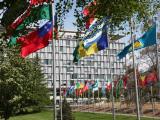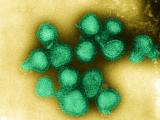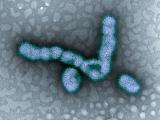Apr 23, 2012 (CIDRAP News) – A large-scale study suggests that antiviral treatment saved many lives during Mexico's 2009 H1N1 influenza pandemic but also points to an irony: that the use of antivirals dropped sharply in the fall wave of cases.
The study of confirmed H1N1 flu cases tracked through Mexico's social security system showed that antiviral treatment cut the risk of death by close to half. The investigators found that about 50% of H1N1 patients received antiviral treatment during the spring and summer waves, but the rate dropped to 9% in the fall wave, according to the report, published in BMC Infectious Diseases.
In addition, the report by a US-Mexican team showed that for patients who were hospitalized with H1N1, delayed hospitalization increased the risk of death close to threefold.
"Overall, our findings suggest that higher rates of timely antiviral treatment during the 2009 fall pandemic wave in Mexico could have led to a substantially lower death toll," the report says.
The investigators, with Gerardo Chowell, PhD, of Arizona State University as first author, used data from a prospective epidemiologic surveillance system that the Mexican Institute for Social Security (IMSS)—a health system covering about 40% of the Mexican population—set up specifically for the 2009 pandemic. They obtained information on patients who sought treatment for influenza-like illness (ILI) at a clinic or hospital from April through December 2009.
In Mexico, treatment with oseltamivir (Tamiflu) or zanamivir (Relenza) was recommended for all ILI patients with severe symptoms and for those with mild symptoms if they were in a high-risk group, the report says.
A total of 117,818 ILI cases were reported to the IMSS from April to December 2009, the authors found. The total number of lab-confirmed H1N1 cases was 27,437, including 3,991 hospital cases.
During the spring pandemic wave, defined as Apr 1 through May 20, 48.6% of confirmed H1N1 patients received antiviral treatment, the researchers found. This proportion increased to 54.9% in the summer wave (May 21 to Aug 1), but it then dropped to just 8.7% in the fall wave (Aug 2 to Dec 31).
After adjusting statistically for age, gender, geographic region, and pandemic wave, the investigators found that antiviral treatment reduced the risk of death for H1N1 patients by 48% (odds ratio, 0.52; 95% confidence interval, 0.30 to 0.90).
The authors found that delayed hospitalization was the strongest predictor of death for confirmed H1N1 patients. The case-fatality rate (CFR) was 23.3% (375 of 1,610) for those who were admitted more than 2 days after onset of symptoms, versus 8% (177 of 2,233) for patients who were admitted 2 days or less after onset, a significant difference (P<.0001).
In examining CFRs, the authors found an overall rate of 2.1% in confirmed cases, with much variation by age and pandemic wave. The CFR for those under 18 years was 0.6%; for 18 to 49 years, 2.8%; and for 50 and older, 8.5%. For hospital patients the CFR was much higher—14.4%—than the overall rate.
During the spring wave the CFR was 4.6%. This dropped to 0.7% in the summer wave, but it rebounded to 2.5% in the fall wave, the report says. Overall, the rate was more than twice as high during the fall wave, when antiviral use was low, as during the spring and summer waves (2.4% versus 1.1%), the authors write.
They comment that pandemic CFRs varied widely from country to country and that the observed Mexican CFRs of 2.1% overall and 14% for hospital patients were high compared with many other countries. (A World Health Organization [WHO] report in 2010 estimated the overall CFR for H1N1 cases at slightly less than 0.5%.) The high estimates for Mexico probably reflect a bias of the Mexican flu influenza surveillance system toward higher severity because of difficulties in identifying asymptomatic or mild cases, they state.
The investigators suggest that changes in the perceived severity of the pandemic may help explain the decrease in antiviral treatment during the fall wave. The severity of the illness was highly uncertain in the early days, and early data suggested unusually severe disease.
"By the end of the summer 2009 pandemic wave, it became clear that the severity of the 2009 pandemic virus was comparable to that of contemporaneous seasonal influenza epidemics," the report says. "Accordingly, antivirals were administered much more conservatively although antiviral availability was not an issue at IMSS facilities."
Chowell G, Viboud C, Simonsen L, et al. Impact of antiviral treatment and hospital admission delay on risk of death associated with 2009 A/H1N1 pandemic influenza in Mexico. BMC Infect Dis 2012 Apr 20 (Early online publication) [Full text]
See also:
WHO committee report on clinical aspects of pandemic 2009 flu, in May 6, 2010, New England Journal of Medicine


















